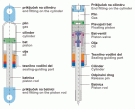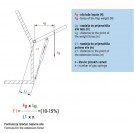A gas spring is a closed system with innerly defined pressure of nitrogen. It consists of a piston rod, a cylinder, a sealing-guiding unit and end fittings (see Picture 1). The pressure inside the cylinder multiplied by the cross-section of the piston rod defines the extension force of the gas spring: F1 = p x A.
Picture 2 shows how to calculate the extension force of a gas spring regarding the position and the weight of the load. The highest pressure of a fully extended, unloaded, gas spring is 160 bars. In order to make a gas spring help us lift a particular load, it must first be compressed, which increases the pressure inside the cylinder.
The difference in pressure makes the gas spring lift the load and keep it in the final position. The result of the change in pressure is indicated in the characteristic of the gas spring, as seen in the diagram force – stroke (see Picture 3).
The piston rod of an unloaded gas spring is always in the extended position. A minor quantity of oil inside the cylinder lubricates the seals and ensures increased damping at the end of extension.



